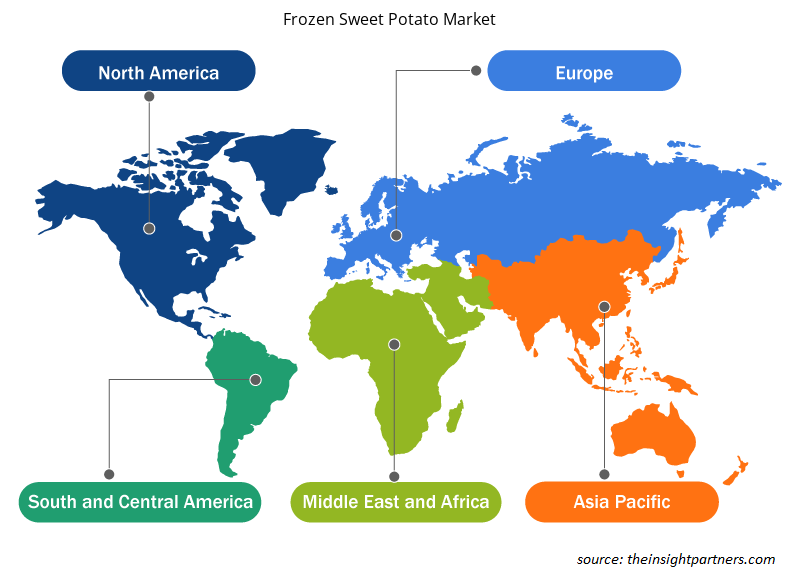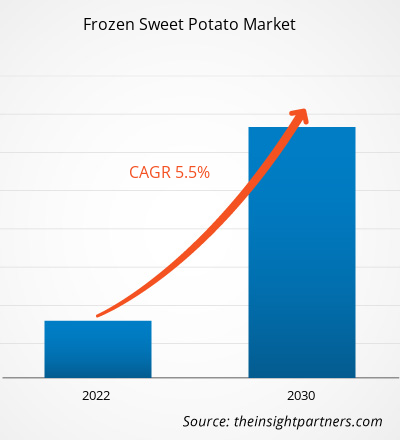[Forschungsbericht] Der Markt für gefrorene Süßkartoffeln wurde auf 3.982,50 Millionen US-Dollar im Jahr 2022 und soll bis 2030 6.105,37 Millionen US-Dollar erreichen; der Markt soll von 2022 bis 2030 eine durchschnittliche jährliche Wachstumsrate (CAGR) von 5,5 % verzeichnen.CAGR of 5.5% from 2022 to 2030.
Markteinblicke und Analystenansichten:
Tiefgekühlte Süßkartoffelprodukte bieten eine praktische und vielseitige Möglichkeit, dieses nahrhafte Wurzelgemüse in eine Mahlzeit zu integrieren. Ob in Form von Pommes Frites, Wedges, Nuggets, Rösti oder anderen Produkten, diese Tiefkühlprodukte bieten eine zeitsparende Lösung für vielbeschäftigte Menschen, die ihre Ernährung gesund ergänzen möchten. Der veränderte Lebensstil der Menschen und hektische Arbeitspläne treiben die Nachfrage nach Fertiggerichten an. Die Menschen tendieren zu Produkten, die ihnen Komfort bieten und ihnen helfen, Zeit zu sparen. Diese Faktoren treiben die Nachfrage nach Tiefkühlkost an. Tiefkühlkost lässt sich zu Hause einfach und ohne Zeitaufwand zubereiten. Darüber hinaus ist sie länger haltbar und leicht zu lagern. Tiefgekühlte Süßkartoffeln werden aufgrund ihres vielseitigen Geschmacks und ihrer knusprigen Textur bei jüngeren Menschen und Kindern zu beliebten Snacks. Die steigende Nachfrage nach Tiefkühlkost und die zunehmende Beliebtheit von tiefgekühlten Süßkartoffelprodukten treiben also das Marktwachstum an.
Wachstumstreiber und Herausforderungen:
Das Aufkommen des E-Commerce hat zu erheblichen Veränderungen in der Art und Weise geführt, wie Menschen einkaufen und Lebensmittel kaufen. Die zunehmende Verbreitung von Smartphones und des Internets, der schnelle Zugang zu neuen Technologien, die steigende Kaufkraft und die Bequemlichkeit, die Online-Einzelhandelsplattformen bieten, gehören zu den Schlüsselfaktoren, die den E-Commerce stärken. Die Menschen bevorzugen zunehmend Online-Einzelhandelsplattformen für den Kauf von Tiefkühlkost. Laut dem American Frozen Food Institute stiegen die Online-Verkäufe von Tiefkühlkostprodukten, einschließlich Tiefkühlsnacks, im Jahr 2020 um 75 %. Die Online-Verkäufe von Lebensmitteln und Getränken stiegen während des COVID-19-Ausbruchs aufgrund der Schließung von stationären Geschäften und der Verhängung mehrerer sozialer Beschränkungen durch Regierungen verschiedener Länder auf der ganzen Welt erheblich an. Mit der zunehmenden Verbreitung des E-Commerce in mehreren Regionen verstärken auch Hersteller von Tiefkühlkost wie Conagra Brands Inc., McCain Foods Ltd. und Aviko BV ihre Online-Präsenz, indem sie Produkte über Amazon, Tesco und andere bekannte E-Commerce-Plattformen verkaufen. Die zunehmende Nutzung von E-Commerce-Plattformen beseitigt die Abhängigkeit von Offline-Einzelhandelsgeschäften. Daher wird erwartet, dass die steigenden Umsätze bei Tiefkühlsnacks über E-Commerce-Plattformen im Prognosezeitraum lukrative Möglichkeiten für ein Wachstum des Marktes für tiefgekühlte Süßkartoffeln schaffen werden.
Kühlkettenlogistik ist für den reibungslosen Ablauf und die weltweite Verbreitung des Tiefkühlsüßkartoffelgeschäfts unerlässlich. In mehreren Entwicklungsländern in beiden Regionen fehlt jedoch immer noch die Kühlketteninfrastruktur, sodass sie den Verbrauchern keine sicheren Tiefkühlprodukte anbieten können. Obwohl Tiefkühlprodukte eine lange Haltbarkeit haben, ist ihr Abfall unvermeidlich, wenn sie während der Handhabung, des Transports und der Lagerung nicht bei den angegebenen niedrigen Temperaturen gelagert werden, was zu verunreinigten Produkten führt. Daher behindert das Risiko des Abfalls von Tiefkühlprodukten aufgrund der fehlenden Kühlketteninfrastruktur in Entwicklungsländern das Wachstum des Marktes für Tiefkühlsüßkartoffeln.
Passen Sie diesen Bericht Ihren Anforderungen an
Sie erhalten kostenlos individuelle Anpassungen an jedem Bericht, einschließlich Teilen dieses Berichts oder einer Analyse auf Länderebene, eines Excel-Datenpakets sowie tolle Angebote und Rabatte für Start-ups und Universitäten.
- Holen Sie sich die wichtigsten Markttrends aus diesem Bericht.Dieses KOSTENLOSE Beispiel umfasst eine Datenanalyse von Markttrends bis hin zu Schätzungen und Prognosen.
Berichtssegmentierung und -umfang:
Die globale Marktanalyse für tiefgekühlte Süßkartoffeln wird nach Typ, Kategorie, Endverbraucher und Geografie kategorisiert. Nach Typ ist der Markt in Pommes frites, Nuggets und Puffs, Wedges, Hashbrowns und andere unterteilt. Nach Kategorie ist der Markt in Bio und konventionell unterteilt. Nach Endverbraucher ist der Markt in Gastronomie und Lebensmitteleinzelhandel unterteilt. Nach Geografie ist der Markt grob in Nordamerika, Europa, Asien-Pazifik (APAC), Naher Osten und Afrika (MEA) sowie Süd- und Mittelamerika unterteilt. Der Markt in Nordamerika ist weiter in die USA, Kanada und Mexiko unterteilt. Der europäische Markt ist weiter in Deutschland, Frankreich, Großbritannien, Italien, Spanien und den Rest von Europa unterteilt. Der Markt im Asien-Pazifik-Raum ist weiter in China, Indien, Japan, Australien, Südkorea und den Rest des Asien-Pazifik-Raums unterteilt. Der Markt im MEA ist weiter in Südafrika, Saudi-Arabien, die Vereinigten Arabischen Emirate und den Rest des MEA unterteilt. Der Markt in Süd- und Mittelamerika wird weiter unterteilt in Brasilien, Argentinien und den Rest von Süd- und Mittelamerika.
Segmentanalyse
Basierend auf der Kategorie wird der Markt für tiefgefrorene Süßkartoffeln in konventionelle und biologische unterteilt. Das konventionelle Segment hält einen bedeutenden Marktanteil an tiefgefrorenen Süßkartoffeln, und biologische Süßkartoffeln werden im Prognosezeitraum voraussichtlich erheblich wachsen. Bio-Tiefkühl-Süßkartoffelprodukte werden aus biologisch angebauten Süßkartoffeln hergestellt. Die Nachfrage nach tiefgefrorenen Süßkartoffeln wird auf die wachsende Vorliebe der Verbraucher für gesündere und umweltbewusstere Lebensmittel zurückgeführt. Bio-Produkte werden als frei von synthetischen Pestiziden und Chemikalien wahrgenommen, was dem steigenden Bewusstsein für gesundheitliche Bedenken im Zusammenhang mit synthetischen Chemikalien entspricht. Verbraucher suchen zunehmend nach Produkten, die sowohl praktisch als auch ernährungsphysiologisch vorteilhaft sind.
Regionale Analyse:
Von allen großen Regionen dominierte Nordamerika im Jahr 2022 den Markt für gefrorene Süßkartoffeln. Der Markt in dieser Region wurde im Jahr 2022 auf 1.240,95 Millionen US-Dollar geschätzt. Europa ist der zweitgrößte Marktteilnehmer und hält etwa 29 % des Marktanteils an gefrorenen Süßkartoffeln. Die Markttrends für gefrorene Süßkartoffeln in Nordamerika werden auf den wachsenden Konsum von Süßkartoffeln, die steigende Nachfrage nach Fertiggerichten, zunehmende Initiativen zur Produktförderung und das wachsende Interesse an gesunden Lebensmitteln zurückgeführt. Der Markt für Süßkartoffeln in Nordamerika ist in den vergangenen Jahren deutlich gewachsen und wird auch in Zukunft weiter wachsen.
Branchenentwicklungen und zukünftige Chancen:
Nachfolgend sind verschiedene Initiativen der wichtigsten Akteure auf dem Markt für tiefgefrorene Süßkartoffeln aufgeführt:
- Im März 2022 kündigte KUK die Einführung tiefgefrorener Süßkartoffelchips in Dubai, VAE, an; Ziel der Markteinführung war die Erweiterung des Produktportfolios und der Kundenbasis.
Regionale Einblicke in den Markt für gefrorene Süßkartoffeln
Die regionalen Trends und Faktoren, die den Markt für gefrorene Süßkartoffeln während des gesamten Prognosezeitraums beeinflussen, wurden von den Analysten von Insight Partners ausführlich erläutert. In diesem Abschnitt werden auch Marktsegmente und Geografie für gefrorene Süßkartoffeln in Nordamerika, Europa, im asiatisch-pazifischen Raum, im Nahen Osten und Afrika sowie in Süd- und Mittelamerika erörtert.

- Erhalten Sie regionale Daten zum Markt für gefrorene Süßkartoffeln
Umfang des Marktberichts über gefrorene Süßkartoffeln
| Berichtsattribut | Details |
|---|---|
| Marktgröße im Jahr 2022 | 3.982,50 Millionen US-Dollar |
| Marktgröße bis 2030 | 6.105,37 Millionen US-Dollar |
| Globale CAGR (2022 - 2030) | 5,5 % |
| Historische Daten | 2020-2022 |
| Prognosezeitraum | 2022–2030 |
| Abgedeckte Segmente | Nach Typ
|
| Abgedeckte Regionen und Länder | Nordamerika
|
| Marktführer und wichtige Unternehmensprofile |
|
Marktteilnehmerdichte für gefrorene Süßkartoffeln: Auswirkungen auf die Geschäftsdynamik verstehen
Der Markt für gefrorene Süßkartoffeln wächst rasant, angetrieben von der steigenden Nachfrage der Endverbraucher aufgrund von Faktoren wie sich entwickelnden Verbraucherpräferenzen, technologischen Fortschritten und einem größeren Bewusstsein für die Vorteile des Produkts. Mit steigender Nachfrage erweitern Unternehmen ihr Angebot, entwickeln Innovationen, um die Bedürfnisse der Verbraucher zu erfüllen, und nutzen neue Trends, was das Marktwachstum weiter ankurbelt.
Die Marktteilnehmerdichte bezieht sich auf die Verteilung der Firmen oder Unternehmen, die in einem bestimmten Markt oder einer bestimmten Branche tätig sind. Sie gibt an, wie viele Wettbewerber (Marktteilnehmer) in einem bestimmten Marktraum im Verhältnis zu seiner Größe oder seinem gesamten Marktwert präsent sind.
Die wichtigsten auf dem Markt für gefrorene Süßkartoffeln tätigen Unternehmen sind:
- Conagra Brands Inc
- Ardo Foods NV
- Aviko BV
- Birds Eye GmbH
- Lamb Weston Holdings Inc
Haftungsausschluss : Die oben aufgeführten Unternehmen sind nicht in einer bestimmten Reihenfolge aufgeführt.

- Überblick über die wichtigsten Akteure auf dem Markt für gefrorene Süßkartoffeln
Auswirkungen von COVID-19:
Die COVID-19-Pandemie betraf fast alle Branchen in verschiedenen Ländern in Nordamerika, Europa, im asiatisch-pazifischen Raum (APAC), in Süd- und Mittelamerika (SAM) sowie im Nahen Osten und Afrika (MEA). Verschiedene Branchen, darunter die Lebensmittel- und Getränkeindustrie, erlitten aufgrund von Störungen der Lieferketten und Schließungen von Produktionsanlagen im Zuge der COVID-19-Pandemie schwere Störungen. Viele Unternehmen kündigten mögliche Verzögerungen bei Produktlieferungen und Einbrüche ihrer zukünftigen Verkäufe an. So behinderten Betriebsunterbrechungen in verschiedenen Branchen das Wachstum des Marktes für gefrorene Süßkartoffeln im Jahr 2020.
Im Gegenteil, die COVID-19-Pandemie veränderte die globalen Verbraucherpräferenzen, da Gesundheit zu ihrer obersten Priorität wurde. Die Vorliebe für gesunde Snacks sowie die Nachfrage nach Produkten mit Bio-Zutaten stiegen. Dieser Faktor löste die Nachfrage nach tiefgekühlten Süßkartoffeln aus. Schwere Störungen des Vertriebsnetzes und Betriebsschließungen führten jedoch zu einer weltweiten Nachfrage- und Angebotslücke. Die Hersteller auf dem Markt für tiefgekühlte Süßkartoffeln erlebten einen Arbeitskräftemangel und standen vor Herausforderungen bei der Beschaffung von Rohstoffen, was sich negativ auf ihre Rentabilität auswirkte. Im Jahr 2021 kündigten die Regierungen verschiedener Länder Lockerungen der Beschränkungen wie Handelsverbote, Lockdowns und Betriebsschließungen an. Den Herstellern wurde erlaubt, mit voller Kapazität zu arbeiten, was ihnen half, die Nachfrage- und Angebotslücken zu überwinden. Mit der Einführung von Impfstoffen erlebte der Markt außerdem eine Erholung, die dem Markt für tiefgekühlte Süßkartoffeln zugute kam.
Wettbewerbslandschaft und Schlüsselunternehmen:
Conagra Brands Inc, Ardo Foods NV, Aviko BV, Birds Eye Ltd, Lamb Weston Holdings Inc, Le Duc Fine Food BV, McCain Foods Ltd, Mondial Foods BV, Handy Food Innovation Ltd und Sunbulah Food & Fine Pastries Manufacturing Co Ltd gehören zu den Top 10 Unternehmen im globalen Marktbericht für tiefgefrorene Süßkartoffeln. Diese Unternehmen konzentrieren sich auf die Entwicklung von Bioprodukten, was dem Markt in den kommenden Jahren voraussichtlich neue Möglichkeiten bieten wird.
- Historische Analyse (2 Jahre), Basisjahr, Prognose (7 Jahre) mit CAGR
- PEST- und SWOT-Analyse
- Marktgröße Wert/Volumen – Global, Regional, Land
- Branchen- und Wettbewerbslandschaft
- Excel-Datensatz
Aktuelle Berichte
Verwandte Berichte
Erfahrungsberichte
Grund zum Kauf
- Fundierte Entscheidungsfindung
- Marktdynamik verstehen
- Wettbewerbsanalyse
- Kundeneinblicke
- Marktprognosen
- Risikominimierung
- Strategische Planung
- Investitionsbegründung
- Identifizierung neuer Märkte
- Verbesserung von Marketingstrategien
- Steigerung der Betriebseffizienz
- Anpassung an regulatorische Trends





















 Kostenlose Probe anfordern für - Markt für gefrorene Süßkartoffeln
Kostenlose Probe anfordern für - Markt für gefrorene Süßkartoffeln